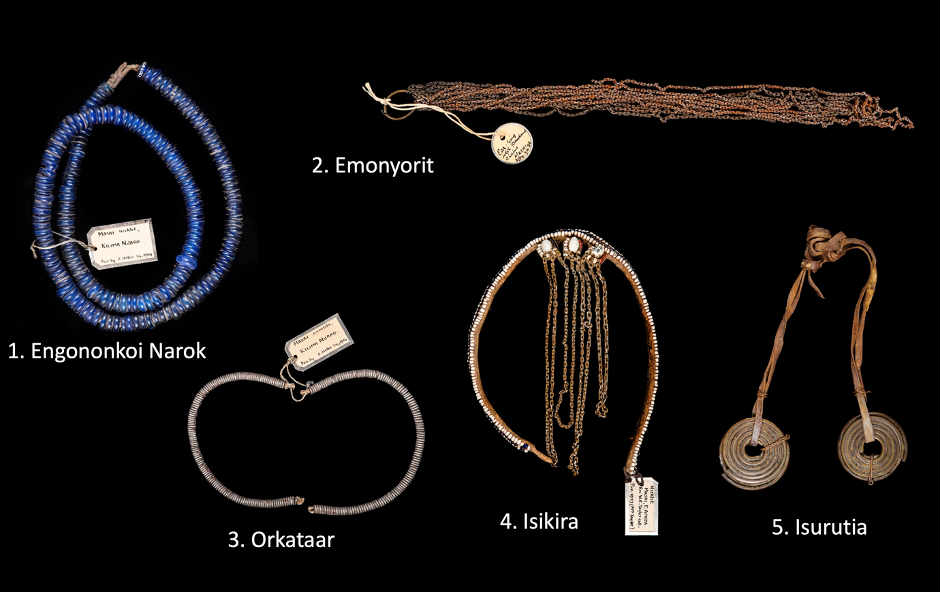2023 Project Update
The Maasai Living Cultures Project is a collaboration between the Pitt Rivers Museum and Maasai community leaders (PALCA). The project is funded by the Staples Trust, a Sainsbury family charitable trust. It is part of one strand of the Museum's ongoing work to build equitable relations with Indigenous Peoples whose material culture is represented in the Pitt Rivers collections.
The project began in 2017 when Maasai cultural leaders visited the Museum to see Maasai objects. Over the following years, further research and additional visits took place and five objects were identified as culturally sensitive family heirlooms. None of the objects have been on display or the subject of research at the Museum. In Maasai tradition, their absence from a family is believed to incur bad luck, so the objects' presence in the Museum continues to cause harm to descendants. The Museum has subsequently taken guidance from Maasai traditional and religious leaders to find ways forward with regards to the care of the objects.
The project marked a key milestone in June and July 2023. Director of the Pitt Rivers Museum, Prof. Laura Van Broekhoven; Curator, Marina de Alarcon and Research Assistant Thandi Wilson visited Kenya and Tanzania to participate in an educational programme and take part in traditional Maasai healing ceremonies and meetings with the families close to their homes. The Museum also presented symbolic gifts of cows, funded by the Staples Trust, to the families in question.
The project and participation in Maasai ceremonies represents pioneering academic work in contemporary museum practice. Professor Laura van Broekhoven said: "The Pitt Rivers Museum's mission is to engage people across the world, increase understanding of humanities' many ways of knowing and extend our reach through innovative partnerships such as this one.
We are deeply honoured to have been invited to take part in traditional Maasai ceremonies in Kenya and Tanzania. We hope this process of redress, which has been led by the Maasai over the past six years, makes a meaningful impact on Maasai families, who are the descendants of the people whose objects were taken during periods of war and colonial oppression."
Samwel Nangiria, Director of PALCA, said: "This process has brought Maasai nations together across borders. These meetings are a unique, historic occurrence bringing the leadership of twenty five sections that represent over 1 million Maasai living in Kenya and Tanzania together for the first time in over a century."
Mokompo Ole Simel, the Maa Nation Spiritual Leader, said: "Reconciliation is not only about closing a sad chapter of Maasai community's past, but about opening new healing pathways of reconciliation that are forged in truth and justice."
Jessica Frankopan, Settlor of The Staples Trust, said: "I am hugely grateful to all of those involved in this project - and especially to Maasai community leaders - for the dialogue, co-operation and support over the last six years. We have worked on issues that are sensitive and extremely important and have been able to do so by building relationships based on trust. Thank you to all for working so hard to make this happen."
Nick Lunch, Director of InsightShare, said: "Participatory video has provided a bridge linking the staff at the Museum with the Maasai community, and enabled Maasai youth and elders to reshape the narratives linked to the artefacts, bringing lived experience into the museum gallery."

What are the five culturally sensitive objects?
The objects identified as being culturally sensitive are:
1. Engononkoi Narok - A hereditary necklace of blue beads passed from father to son, a crucial element of initiation ceremonies. It should never be sold or given away. (Accession number: 1904.34.25) Collector: Alfred Claud Hollis
2. Emonyorit - Earring worn by young women after circumcision, reconfigured into a neck ornament after marriage. It would never stay permanently in this state. (Accession number: 1904.34.36) Collector: Alfred Claud Hollis
3. Orkatar/Orkataar - Hereditary bracelet passed from father to son, which should never be sold or given away. (Accession number: 1904.34.38.1-2) Collector: Alfred Claud Hollis
4. Isikira - Head ornament worn by newly circumcised girls. It can only be used by one specific person and would always be dismantled after use. It can never be borrowed, sold or given away. (Accession number: 1927.84.51) Collector: Rev.William Ernest Taylor
5. Isurutia - Hereditary woman's ear/neck pendant which represents the sacred bond of marriage. It can never be borrowed, sold or given away. (Accession number: 1996.21.77) Collector: Phoebe Somers
Team Delegates
- Laura Van Broekhoven, Director of the Pitt Rivers Museum
- Marina de Alarcon, Head of Collections at the Pitt Rivers Museum
- Thandiwe Wilson, Pitt Rivers Museum Research Assistant and PhD student
- Jessica Frankopan, The Staples Trust
- Iliane Ogilvie Thompson, Pitt Rivers Museum Board of Visitors member
- Ollie Douglas, Museum of Rural English Life, University of Reading
- Nick Lunch, Director of InsightShare
- Robert Newman, Freelance videographer
The Maasai are the priority partners in this project and they have led the process. The Museum has listened to Maasai people, respected their wishes and worked collaboratively to find a way forward.
Six ceremonies took place from 26 June - 5 July 2023.
The ceremonies involved blessings of the campsites, the ceremonial gift of the cows to the families led by Maasai experts, and ceremonial breakfasts with the families. The delegates also participated in opening and closing ceremonies that involved meetings with Maasai leaders.
- Professor Laura van Broekhoven, Director
- Dr. Marina de Alarcon, Head of Collections and Curator
- Ms. Thandiwe Wilson, Research Assistant and PhD student
- Ms. Iliane Ogilvie Thompson, Board of Visitors member
Staff visited Nairobi, Narok, Morijo and Leshuta in Kenya and Kilimanjaro and Arusha in Tanzania.
- The Pitt Rivers Museum
- The Staples Trust - a Sainsbury family charitable trust and project funder
- PALCA - The Pan-Africa Living Culture Alliance, an international organisation led by Maasai cultural leader and activist Samwel Nangiria
- Oltoila la Maa FM - a community-based participatory video group formed in Loliondo, Tanzania
- InsightShare - an Oxford-based educational media company and charity working on participatory video and cultural projects
The Pitt Rivers Museum has 95,327 objects from Africa, which include 9443 from Kenya and 2794 from Tanzania. Of these, 188 are attributed to the Maasai. The Maasai collection includes decorative and ceremonial objects and attire such as neck ornaments, a beadwork belt and a horn trumpet.
1. Engononkoi Narok - A hereditary necklace of blue beads passed from father to son, a crucial element of initiation ceremonies. It should never be sold or given away. (Accession number: 1904.34.25) Collector: Alfred Claud Hollis
2. Emonyorit - Earring worn by young women after circumcision, reconfigured into a neck ornament after marriage. It would never stay permanently in this state. (Accession number: 1904.34.36) Collector: Alfred Claud Hollis
3. Orkatar/Orkataar - Hereditary bracelet passed from father to son, which should never be sold or given away. (Accession number: 1904.34.38.1-2) Collector: Alfred Claud Hollis
4. Isikira - Head ornament worn by newly circumcised girls. It can only be used by one specific person and would always be dismantled after use. It can never be borrowed, sold or given away. (Accession number: 1927.84.51) Collector: Rev. William Ernest Taylor
5. Isurutia - Hereditary woman's ear/neck pendant which represents the sacred bond of marriage. It can never be borrowed, sold or given away. (Accession number: 1996.21.77) Collector: Phoebe Somers
The appropriate gift of cows for Elaata Oo Ngiro ceremonies is 49 per ceremony. This has been funded by the Staples Trust.
We have not received a claim for the return of objects.
If any claims for return were made, we would follow the established University Procedures.
The project will make meaningful, real-world impacts on Maasai people at a time when they are suffering due to land-rights issues and climate change. The project also enhances the Museum's knowledge and understanding of Maasai culture and history, which benefits online and on-site visitors who want to learn about the Maasai and indigenous cultures.
Timeline of the Project
- 2017 Visit of Samwel Nangiria and other indigenous leaders as part of the Indigenous Leadership Training Programme by InsightShare.
- 2018 Concern raised by elders of Loliondo (via video) and invitation to engage.
- 2018 First delegation of five Maasai representatives highlight five objects of concern (out of total of 188 objects) and identify other objects. This information is used to correct inaccurate records on database.
- 2019 Maasai delegates work with Chief Mokompo and Maa representatives to identify the best way forward.
- 2020 Second delegation of seven Maasai representatives, including Laibon Lemaron Ole Parit, visit Pitt Rivers Museum, Oxford, Horniman Museum, London and the Museum of Anthropology & Archaeology, Cambridge, to identify how (using Maasai systems of knowledge) the five objects of concern were brought here, which families are affected by their absence and what the possible ways of reconciliation are.
- 2020-2021 Reports by Mokompo on the possible ways forward for reconciliation, such as the Elata Oo Ngiro ceremony. A Radical Hope webinar provides a forum for open discussion on the options.
- 2020-2021 Work with Pitt Rivers Museum Learning Team and Assistant Researcher, Thandi Wilson, to make new educational materials, including handling objects and films.
- 2022 Next phase funding for pilgrimage by Maasai to affected families.
- 2023 Elata Oo Ngiro ceremony to take place in June/July led by PanAfrican Living Cultures Alliance (PALCA), which will be responsible for running the ceremony, including the buying of the cows and all ritual and diplomatic parts of the process.








